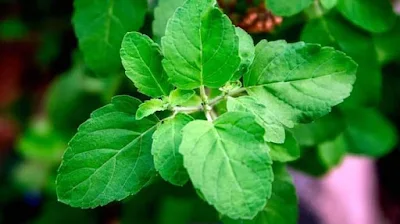Botanical Name(s): Ocimum Sanctum
Family Name: Lamiaceae
Kingdom: Plantae
Division: Magnoliophyta
Class: Magnoliopsida
Order: Lamiales
Family: Lamiaceae
Genus: Ocimum
Species: O. basilicum
Popular Name(s): Basil, Common Basil, French Basil, Garden Basil, Sacred Basil, Holy Basil, Tulsi, Royal Herb, Luole, Sweet Basil.
Parts Used: Leaves, Seeds.
Habitat: Found throughout India
Description
The term ‘basil’ has been derived from a Greek word ‘basileus’, which means ‘king’. It is a tender, low-growing herb that reaches a height of 1 to 2 feet. The stem of the plant bears many leaves, having a characteristic purple hue or coloration. The flowers are peculiar, in having two lips. The flower color can vary from pure white to pure red, with a slight purple tinge in some flowers. Basil is native to India, Iran and other tropical regions of Asia and has been grown there for more than 5,000 years. It is now cultivated throughout the world, as a flavoring herb in many cuisines. It plays a major role in cuisines of Italy, Thailand, Vietnam, Cambodian and Laos. The herb comes in a number of varieties, like the sweet basil, holy basil, lemon basil and African blue basil.
Plant Chemicals
(+)- volatile oil (linalool, methyl chavicol), methyl cinnamate, cineole, citronellol, geraniol, myrcene, pinene, ocimene, terpineol, E-beta-caryophyllene.
Uses & Benefits of Basil
Fresh basil forms a common ingredient in cooked recipes across the world.
Basil oil has potent antioxidant, anti-cancer, anti-viral and anti-bacterial properties.
Basil has been known to decrease the occurrence of platelet aggregation and experimental thrombus in mice.
In India, it has been traditionally used for the supplementary treatment of stress, asthma and diabetes.
Basil serves as an herbal remedy for diseases related to the brain, heart, lungs, bladder and kidneys.
The herb is mixed with borage to make a tea that heightens vitality. Steaming basil tea is also used for treating patients with fever.
Basil tea is utilized in the internal as well as external treatment of eye problems. It is used as eyewash and the tea is also drunk to treat eye disorders.
Dried basil leaves are used in a snuff, as a remedy for colds.
The herb has been used as an antidote for poison since ancient times.
It is commonly used in cosmetics as a toning body rub, when mixed with sea salt and vegetable oil.
Basil is used for treating disorders of the digestive and nervous systems and reducing the incidence of flatulence in affected individuals.
The herb is helpful in all kinds of cramps in the stomach. It is also used to treat colic, indigestion, nausea, vomiting, intestinal worms, physical tiredness, depression, short-term and long-term anxiety and insomnia.
Herbal remedies made from sweet basil are used in the treatment of epilepsy, migraine and whooping cough.
Sweet basil is applied on insect bites as an external herbal ointment.
The herb is used in malaria, catarrh, bronchitis coughs, headaches, lung problems, abdominal distention, arthritis, nasal congestion, nerve tissue strengthening, sinus congestion, and gastric disorders.
It purifies the air, clears the lungs, and proves to be an effective heart tonic
Basil also lowers blood sugar levels and its powder is used for treating mouth ulcers.
Caution
Intake of basil seeds in large quantities is harmful for the brain.
- Sri Eswaran







